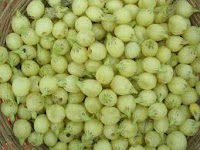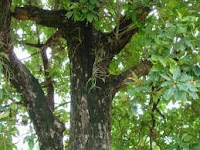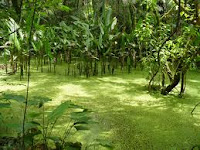SAVOY CABBAGE, BRASSICA OLEOROSA (capitata var. saboude L.)
The green cabbages are all descendants of a wild leafy cabbage which was cultivated so that it became a head (
capitata) cabbage. It is believed that the
Savoy cabbage was developed in the
Savoy region in the 15
th century, which at the time encompassed parts of
France,
Italy and
Switzerland. It is the crinkly-leaved cabbage which, like the
red cabbage has unique health benefits if steamed or lightly sautéed. The savoy cabbage is closely related to the other members of the Brassicaceae or Cruciferae family which include
broccoli,
kale,
kohlrabi,
brussel sprouts and collard or spring greens.
Cabbages may have come from
China via
Egypt into
Europe, although they more likely were indigenous to the Mediterranean region and
Greece, as there are wild mustard plants that grow near the sea which could have been ancestors. They were known to the ancient Greeks and Romans, who used them for both food and medicine as it was believed that cabbage could promote milk-flow in lactating women. However they were also regarded as a nuisance and not grown near
grape vines as they were thought to impart their flavour to the vines and so spoil the wine. Nowadays, they are disliked by children because of their taste, but this can be disguised by trying our recipe below.

You can also substitute steamed cabbage leaves for vine leaves as in our
dolmades recipe.
The cabbage was a staple food for European peasants between the 14th and 19th centuries, along with heavy dark bread. It is a winter vegetable and the Dutch and Germans fermented it and made sauerkraut which was eaten by Dutch sailors to prevent scurvy on the voyages of discovery to what is now Indonesia. Cabbage was introduced to North America by the early German settlers who also gave the continent sauerkraut.
Writing his herbal in the 17
th century, had this to say of cabbages (‘coleworts’ include cabbage and
cauliflower)

“
Government and virtues. The cabbage or coleworts boiled gently in broth, and eaten, do open the body, but the second decoction doth bind the body: the juice thereof drunk in wine, helpeth those that are bitten by an adder; and the decoction of the flowers bringeth down women's courses. Being taken with
honey, it recovereth hoarseness or loss of the voice: the often eating of them, well boiled, helpeth those that are entering into a consumption: the pulp of the middle ribs of colewort, boiled in
almond milk, and made up into an electuary with honey, being taken often, is very profitable for those that are pursy or short-winded; being boiled twice and an old cock boiled in the broth, and drunk, helpeth the pains and the obstructions of the liver and spleen, and the stone in the kidneys; the juice boiled with honey, and dropped into the corner of the eyes, cleareth the sight, by consuming any film or cloud beginning to dim it; it also consumeth the canker growing therein. They are much commended being eaten before meat to keep one from surfeiting, as also from being drunk with too much wine, and quickly make a drunken man sober; for as they say, there is such an antipathy or enmity between the vine and the colewort, that the one will die where the other groweth. The decoction of coleworts taketh away the pains and achs, and allayeth the swellings of swoln or gouty legs and knees wherein many gross and watery humours are fallen, the place being bathed therewith warm: it helpeth also old and filthy sores being bathed therewith, and healeth all small scabs, pushes, and wheals, that break out in the skin; the ashes of colewort-stalk, mixed with old hog's-grease, are very effectual to anoint the sides of those that have had long pains therein, or any other place pained with melancholy and windy humours. Cabbages are extreme windy, whether you take them as meat or as medicine: but colewort-flowers are something more tolerable, and the wholesomer food of the two. The Moon challengeth the dominion of the herb.”

The savoy cabbage has been shown to have unique health benefits, but only if steamed lightly or sautéed lightly. It is a good source of sinigrin which has been the subject of cancer research. The sinigrin found in cabbages converts in the body to allylisothiocyanate (AITC) a compound which has been found to have cancer-protective properties, particularly against bladder, colon and prostate cancers. However if you cook cabbage by long boiling it looses these health-giving properties.
Savoy cabbage and other green cabbages have potent antioxidant properties perhaps due to the polyphenol compounds found in them. They are very nutritious containing
vitamins A, C, E and K, and the
B-complex vitamins, including thiamin (B1) and niacin (B2). They also contain the following
minerals: apart from molybdenum they also contain calcium, a little copper, iron, potassium, zinc, magnesium, manganese, phosphorous, selenium and sodium and they also have all the
amino acids as well as lutein and zeaxanthin, and choline. The amino acid, glutamine, is known to have anti-inflammatory properties, so as Culpeper says, could indeed take away the “pains and achs, and allayeth the swellings of swoln or gouty legs and knees.” Another constituent of the savoy cabbage, indol-3-carbinol, boosts DNA repair in the cells and appears to block the growth of cancerous cells.

In
Eastern Europe, cabbage is frequently cooked with
juniper berries (4 is sufficient for four people) or
caraway seeds (1 teaspoon for four people). However cabbage is usually boiled to death and so the nutrients and health-giving substances are lost. The best way of using a cabbage is to shred or chop it and then let it rest for 5 minutes before steaming or lightly sautéing it.
Why not try this recipe for stir-fried savoy cabbage served on a bed of brown
rice mixed with
wild rice?
STIR-FRIED SAVOY CABBAGE AND CASHEW NUTS
Ingredients
¾ pound of savoy cabbage, shredded and left to settle for 5 minutes before frying

1 medium
onion, finely chopped
3
garlic cloves, finely chopped
METHOD
Heat the oils and add the onion and garlic, and fry until the onion is a pale golden colour.
Add the red pepper, spices, cashew nuts and cabbage and stir-fry for 5 minutes.
When the cabbage is wilted a little it is ready.
Serve on a bed of rice as suggested above.
This has Taste and is a Treat.
 Luckily the wood is not highly prized in the West but is used by people where it grows for coffins, dugout canoes and carvings. The kapok is the silky fine hairs which are attached to the seeds which grow in fruit after the white or perhaps pink flowers have fallen.
Luckily the wood is not highly prized in the West but is used by people where it grows for coffins, dugout canoes and carvings. The kapok is the silky fine hairs which are attached to the seeds which grow in fruit after the white or perhaps pink flowers have fallen. The kapok tree has its medicinal uses too and these vary depending on where it grows, In Samoa the bark is used for asthma, while in the Philippines where trees were planted, the bark is regarded as useful for fever, as a diuretic, for diarrhoea and as a purgative. It is also applied to swollen fingers and wounds, while an infusion is used as mouthwash.
The kapok tree has its medicinal uses too and these vary depending on where it grows, In Samoa the bark is used for asthma, while in the Philippines where trees were planted, the bark is regarded as useful for fever, as a diuretic, for diarrhoea and as a purgative. It is also applied to swollen fingers and wounds, while an infusion is used as mouthwash. A decoction of the flowers is given for constipation and an infusion of the leaves is used for coughs, hoarseness, catarrh and uterine discharge. The tender young leaves are used for gonorrhoea, as are the tender tap roots, which are also used in cases of dysentery. The unripe fruit is demulcent, emollient and astringent so useful to soothe the mucous membrane in cases of bronchitis and so on. A decoction of the roots is given for diarrhoea and chronic dysentery while the gum from the bark is astringent and styptic so good for wound healing. It is sometimes given in milk to children who have diarrhoea or who are incontinent.
A decoction of the flowers is given for constipation and an infusion of the leaves is used for coughs, hoarseness, catarrh and uterine discharge. The tender young leaves are used for gonorrhoea, as are the tender tap roots, which are also used in cases of dysentery. The unripe fruit is demulcent, emollient and astringent so useful to soothe the mucous membrane in cases of bronchitis and so on. A decoction of the roots is given for diarrhoea and chronic dysentery while the gum from the bark is astringent and styptic so good for wound healing. It is sometimes given in milk to children who have diarrhoea or who are incontinent. Clinical studies have shown that the stem bark has liver protective properties and the tree has antioxidant properties, (leaves and stem bark) while root extracts have been found to have anti-diabetic properties.
Clinical studies have shown that the stem bark has liver protective properties and the tree has antioxidant properties, (leaves and stem bark) while root extracts have been found to have anti-diabetic properties.
















































